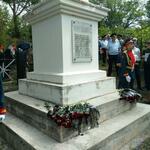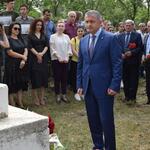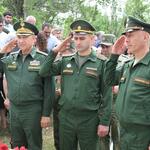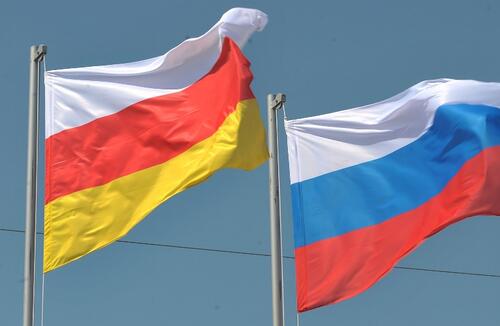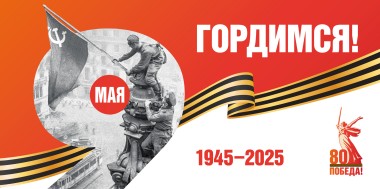Danil Valiev, Nikolay Valiev, Kishil Tskhovrebov, Nikolay Kotolov, Andrey Dzhioev, Pashka Khodov, Sosko Gobozov, Ivan Tedeev, Totr Tskhovrebov, Butu Dzeranov, Rezo Gigolaev, Sasha Gigolaev, Gigo Kumaritov. These are the names of 13 Communards who were shot in 1920. Their memory was honored at the Zguder cemetery, where a memorial monument to the heroes of the Communards is installed.
On June 20, a mourning meeting was held in South Ossetia, dedicated to the 99th anniversary of the execution of 13 Communards. A memorial monument is erected at the Zguder cemetery, where they were shot. The memory of the heroes of the Ossetian people who sacrificed their lives in the name of independence and prosperity of South Ossetia has been honored by the President of South Ossetia Anatoly Bibilov, Chairman of the Government Eric Pukhaev, representatives of the legislative and executive authorities, the public of the Republic, schoolchildren.
Remembering tragic dates
The rally was opened by the historian Murat Dzhioev. He remembered the events of almost a century ago.
“In 1920, it was raining on June 20, and in the morning of that day, 13 people with their hands tied behind their back, surrounded by armed Georgian Mensheviks, left the basement of one of the buildings on the church square (the building of today's Committee on Youth Affairs). They understood perfectly well that they were being led to be killed, but their heads were proudly raised. The communards raised on Zguder mountain, to the place where it was supposed the execution. The Ossetians were given shovels and ordered to dig a ditch. Of course, it was clear what the pit would serve for. They told their punishers in the face that they would not dig their own grave. This statement caused a hitch in the Georgians. While they galloped to the town to gather a group of people who were forced to dig a ditch, the procession was waiting for their fate,” the historian said.
At the place where they were supposed to be killed, the Communards were waited by priest Alexey Kvanchakhadze and doctor Vaclav Hersh. The priest - to let go of sins, and the doctor - to witness the death.
“When the priest approached them for the ritual, Andrei Dzhioev pushed the cross away and said: “We are not guilty of anything, we have no sins, and there is nothing to be absolved” Dzhioev at that time worked as a teacher, and had great prestige among the local population.
The Communards appealed to the villains, so they let go the teenager, who was among them. But they did not even spare him ...
There was a volley and 12 people fell down. One of them ran to the forest. Among the Ossetians were traitors — Artem Lokhov caught up with him on a horse and shot him in the neck from behind. He tied the body to the horse's legs, and he was also thrown into the pit to the rest of the twelve ...,” Murat Dzhioyev continued the story.
According to him, since childhood he had heard about the heroic feat of these 13 guys, moreover, almost every one of them is a relative, neighbor, fellow villager of every resident of South Ossetia.
Murat Dzhioev urged everyone to always remember the tragic dates in the history of South Ossetia, including the Zar tragedy, the Ered, and Tsinagar.
He has reminded that during each attack on the city of Georgian fascists, the Zguder temple of St. George became the patron and defender of the people.
The historian in has stressed that we must fight for justice and convey the truth to the world community. “Every person should tell at various platforms about the events of the 1920s, 1990s, 2000s, about the genocide of the Ossetian people. This struggle was in the name of independence and unification with Great Russia. In 1917, people of South Ossetia held six congresses, and at all they made the decision to be independent from Georgia and join Russia,” the historian said.
The struggle was aimed at the independence from Georgia and joining Russia
The head of state Anatoly Bibilov has noted that there are many tragic and heroic events in the history of the Ossetians. Tragedy and heroism are inextricably linked in this case. Tragedy affects both younger and older people. And people, knowing that they are going to die, show heroism, do not bow their heads before the fascists, do not ask for mercy,” the President said.
According to him, this is one of those episodes that we call the genocide of the Ossetian people. “And there were a lot of such episodes. This struggle has led to the fact that today we can say - in the fight we have won, and we live in the independent state. The struggle was aimed at independence from Georgia and joining Russia. And we have the opportunity to take steps to unite with Russia today. Ossetians consider Russia their historical homeland, since Ossetia became part of Russia in 1774. The most important thing for the Republic and for the people is not to forget the tragic events, and every year to come and pay tribute to the memory of those who died for us, for our children,” said Anatoly Bibilov.
Schoolchildren and teachers of the school "Albion" told about the historical events of those years, the facts of the execution of 13 Communards, the investigative measures and the course of the investigation. Flowers and wreaths were laid at the monument to the Communards.
